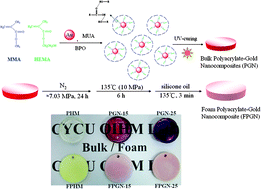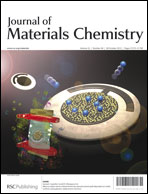In this study, we prepare UV-curable polyacrylate–gold nanocomposites (PGNs) for the first time and analyze their thermal properties. The microemulsion architectures of these PGNs contain gold nanoparticles (GNPs) whose surface is modified with carboxyl groups; furthermore, 2-hydroxyethyl methacrylate (HEMA) and methyl methacrylate (MMA) monomers are first chemisorbed onto the surface of the GNPs and then photopolymerized to form a shell. The effects of the dispersion characteristics of GNPs in a PGN matrix were analyzed by transmission electron microscopy (TEM). PGN foams (FPGNs) can be obtained by subjecting the as-prepared bulk PGN materials to physical batch foaming processes, where nitrogen is used as a blowing agent. The cellular structures of the prepared FPGNs were investigated by scanning electron microscopy (SEM). FPGNs containing 15 nm GNPs (herein, denoted by FPGN-15) were found to exhibit a smaller cell size and a higher cell density than FPGNs containing 25 nm GNPs (herein, denoted by FPGN-25). FPGN materials exhibit an apparent increase in thermal stability (including decomposition temperature (Td)) as well as a decrease in the thermal transport properties (including thermal conductivity (k) and thermal diffusivity (α)) as compared to their corresponding bulk PGN materials. Moreover, results of the measurements of the compression modulus showed that the mechanical strength of FPGN-15 and FPGN-25 increased by 72% and 57%, respectively, as compared to that of neat polyacrylate foam.

You have access to this article
 Please wait while we load your content...
Something went wrong. Try again?
Please wait while we load your content...
Something went wrong. Try again?


 Please wait while we load your content...
Please wait while we load your content...